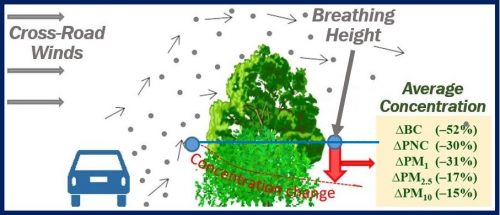To combat near-road pollution, urban planners should plant hedges, say two researchers from the University of Surrey. Urban planners should consider planting either just hedges or a combination of hedges plus trees. However, they should not opt for just planting roadside trees.
Hedges or trees plus hedges are significantly more effective than just trees at reducing pollution from cars. Specifically, exposure to pollution from vehicles in near-road environments, the researchers said.
K. V. Abhijith and Prashant Kumar wrote about their study and findings in the journal Atmospheric Environment (citation below).
The authors looked at three types of road-side green infrastructure:
- Trees.
- Hedges.
- A combination of hedges/shrubs plus trees.
They wanted to determine what effect they had on air pollution levels.
Pollution and air pollution
Pollution is the presence of particulates, chemicals, and other substances in the environment that are toxic or harmful. They may be harmful to plants, animals, humans, or anything that lives. We call it pollution when concentration levels have risen too high.
Air pollution is the release into the atmosphere of harmful substances or particulates. The term also includes their presence in the atmosphere.

Roadside hedges were the best
A far as reducing pollution exposure, roadside hedges were the best, the authors said. They cut black carbon by up to sixty-three percent.
Sub-micron and ultra-fine particles showed the smallest reduction among all the pollutants they measured. A ultra-fine particle has a diameter of less than 2.5 micrometers. One micrometer is one-millionth of a meter or one-thousandth of a millimeter.
Wind direction
When the winds were parallel to the road, pollution levels declined the most. This was due to the ‘sweeping effect.’ The second-greatest reduction occurred when winds went across the road.
The elemental composition of particles indicated a significant decline in harmful heavy metals that originated from traffic behind the hedges.
The hedges only – and also a combination of hedges plus trees – were the most effective green infrastructure at improving air quality under a range of wind directions.
Tree canopy is too high
Roadside trees had no positive effect on pollution reduction as far as human pedestrians are concerned.
In other words, at a human breathing height (1.5 to 1.7 meters), air quality did not improve.
This was because the trees’ canopies were too high to provide a filtering/barrier effect for road-level car tailpipe emissions.
Most people live in urban areas
Over half of the world’s population lives in urban areas, according to UN data. In the European Union, nearly two-thirds of citizens live in urban areas. The European Environment Agency says that air pollution levels exceed permissible levels in many cities. Therefore, air pollution is a primary environmental health risk.
Senior author and the founding director of GCARE at the University of Surrey, Prof. Prashant Kumar , said:
“Many millions of people across the world live in urban areas where the pollution levels are also the highest. The best way to tackle pollution is to control it at the source. However, reducing exposure to traffic emissions in near-road environments has a big part to play in improving health and well-being for city-dwellers.”
“The iSCAPE project provided us with an opportunity to assess the effectiveness of passive control measures such as green infrastructure that is placed between the source and receptors.”
“This study, which extends our previous work, provides new evidence to show the important role strategically placed roadside hedges can play in reducing pollution exposure for pedestrians, cyclists and people who live close to roads. Urban planners should consider planting denser hedges, and a combination of trees with hedges, in open-road environments.”
“Many local authorities have, with the best of intentions, put a great emphasis on urban greening in recent years. However, the dominant focus has been on roadside trees, while there are many miles of fences in urban areas that could be readily complemented with hedges, with appreciable air pollution exposure dividend. Urban vegetation is important given the broad role it can play in urban ecosystems – and this could be about much more than just trees on wide urban roads.”
Citation
Abhijith, K.V., Kumar, P., 2019. “Field investigations for evaluating green infrastructure effects on air quality in open-road conditions.” Atmospheric Environment. Available online 2 January 2019. DOI: https://doi.org/10.1016/j.atmosenv.2018.12.036.

